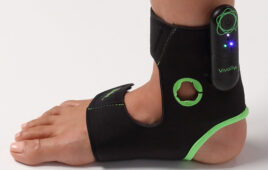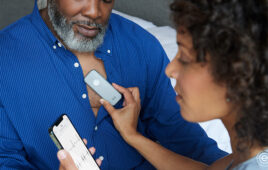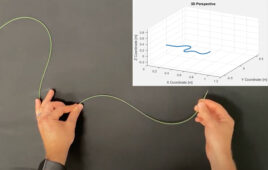TE Connectivity, Schaffhausen, Switzerland

(Image from TE Connectivity)
TE Connectivity has developed Versio, a catheter connector platform designed to be compatible with a variety of medical devices used in cardiac catheterization and other minimally invasive procedures.
Versio offers high-density signal and power connectivity in a low-profile platform to improve access to and sensing within the most complex areas of the body — without changing surgical best practice or clinical workflow, according to the Schaffhausen, Switzerland-based company.
With a diameter of about 1 inch, Versio was designed by TE’s Portland, Ore., team to have 208 contacts — about 2-½ times as many as the competition, according to Tom Medina, an engineering fellow in the company’s medical business unit.
“The key innovation is being able to present to the clinical world this kind of high-density connectivity in the imaging space and the electrophysiology space,” Medina said.
Customers for these types of applications want higher resolution to produce better images and shorten procedure times, he added. This requires more connections, but the handle can’t be too large or heavy.
The main challenge to company engineers in Kawasaki, Japan, was fitting 208 contacts in a 1-in. diameter. They solved this using printed circuits and multiple rows of contacts. They also had to use thin walls able to withstand the force of mating with the catheter and maintain the signal in up to 1000 uses.
“I’m challenging these guys with requirements where the components need to be very small to fit into the overall volume,” Medina explained. “We have in aggregate a very high amount of contact force that we need to manage, but structurally it’s a real challenge to get that kind of robustness in the overall structure when the diameter is so small. And then I’m asking them to design it so that it works consistently for over 1000 mate cycles.”
The printed circuit board also had to offer enough separation between contacts to control impedance and thus, image quality.
“The design is very simple, but manufacturing is very difficult,” said Makiya Kimura, a product development engineering manager at TE’s Japan headquarters in Kawasaki.
Customers also wanted the company to incorporate human factors engineering into their design from the beginning. TE engineers had to make sure the device would feel comfortable in the hand and be easy to use. Multiple cardiologists also told the company that they want to be able to feel the connection being made when they insert the catheter into the connector, because their view is often blocked by a sheath to maintain the sterile field.
Versio can also be designed with different electrical requirements for custom applications, Medina said. The company’s plan is to make a platform variant that can be used in up to 10,000 cycles. The first version of Versio is scheduled for release in August.




